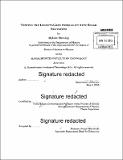Testing the Leggett-Garg inequality with solar neutrinos
Author(s)
Murskyj, Mykola
DownloadFull printable version (2.923Mb)
Other Contributors
Massachusetts Institute of Technology. Department of Physics.
Advisor
David Kaiser.
Terms of use
Metadata
Show full item recordAbstract
One of the fundamental questions in quantum physics is whether measurements reveal pre-existing values. Leggett and Garg derived an inequality that is satisfied by systems featuring both macroscopic realism and non-invasive measurability. The Leggett-Garg Inequality places a quantum-classical limit on a linear combination of correlation functions of a series of measurement outcomes. The flavor oscillations of solar neutrinos provide an interesting way to test the Leggett-Garg inequality, and on an astrophysical length scale. Beginning as electron neutrinos in the solar core, they undergo the Mikheyev-Smirnov-Wolfenstein Effect and exit the sun in either of two mass eigenstates, depending on their energy. Using the neutrino energy to predict the flavor state when it begins traversing the vacuum between the sun and the Earth, we can construct two-time correlation functions of the flavor state at creation, after the MSW effect, and upon detection here on Earth. We can then use these correlation functions to test whether neutrino flavor oscillations obey or violate the Leggett-Garg inequality. Una delle domande fondamentali della fisica quantistica 6 se le misurazioni rivelano valori preesistenti. Leggett e Garg hanno derivato una disuguaglianza che viene soddisfatta da sistemi caratterizzati sia dal realismo macroscopico che dalla misurabilitd non invasiva. La disuguaglianza Leggett-Garg pone un limite quantistico-classico su una combinazione lineare di funzioni di correlazione di una serie di risultati di misura. Le oscillazioni di sapore dei neutrini solari forniscono un modo interessante per testare la disuguaglianza Leggett-Garg, e su una scala di lunghezza astrofisica. Utilizzando l'energia dei neutrini per prevedere lo stato di sapore quando comincia ad attraversare il vuoto tra il sole e la Terra, possiamo costruire funzioni di correlazione due volte dello stato di sapore al momento della creazione, dopo l'effetto MSW, e al rilevamento qui sulla Terra. Possiamo poi utilizzare queste funzioni di correlazione per verificare se oscillazioni di sapore dei neutrini obbediscono o violano la disuguaglianza Leggett-Garg.
Description
Thesis: S.M., Massachusetts Institute of Technology, Department of Physics, 2015. Cataloged from PDF version of thesis. Includes bibliographical references (pages 47-48).
Date issued
2015Department
Massachusetts Institute of Technology. Department of PhysicsPublisher
Massachusetts Institute of Technology
Keywords
Physics.